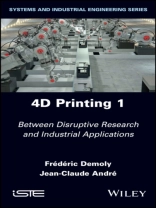Any time objects and their (self-)organization are to be put into use, their models and methods of thinking as well as their designing and manufacturing need to be reinvented.
4D printing is a future technology that is capable of bringing 3D objects to life. This ability, which gives objects the power to change shape or properties over time through energy stimulation from active materials and additive manufacturing, makes it possible to envisage technological breakthroughs while challenging the relationship between people and objects.
4D Printing 1 presents the different facets of this technology, providing an objective, critical and even disruptive viewpoint to enable its existence and development, and to stimulate the creative drive that industry, society and humanity need in the perpetual quest for evolution and transformation.
विषयसूची
Foreword ix
Jean-Charles Pomerol
Preface xi
Preamble xvii
Introduction lvii
Chapter 1 Is 4D Printing Disruptive or Incremental, or a Bit of Both? 1
1.1 Introduction 1
1.2 Prospective approach 4
1.3 A tectonics of paradigms 13
1.3.1 3D printing 14
1.3.2 4D printing 17
1.3.3 The potential development of 4D innovations 21
1.3.4 Note: example of 4D printing in structural electronics (SE) 25
1.3.5 Partial conclusion 32
1.4 4D printing: breakthrough or increment? 37
1.4.1 Creativity and 4D printing 39
1.4.2 Getting out of blindly following? Where to go? 44
1.4.3 Application to additive manufacturing 47
1.4.4 Application to 4D printing 48
1.5 Financial and organizational aspects 50
1.5.1 Research funding and direction 50
1.5.2 Constraints/opportunities related to research orientation 55
1.6 A hopeful conclusion within an organization that learns 66
1.6.1 General framework 66
1.6.2 Organizing research in 4D printing 67
1.7 Appendix 1: Processing an external file 71
1.8 Appendix 2: Going a step further (working document) 74
1.8.1 Can we break the deadlock? 80
1.8.2 So what? 82
1.9 References 84
Chapter 2. Is There External Creativity to Support 4D Printing? 117
2.1 Introduction 118
2.2 A survey for the general public 118
2.2.1 The survey 119
2.2.2 Items not transmitted 121
2.2.3 Some general survey results 126
2.2.4 Note: English language survey 130
2.3 Results of the survey 132
2.3.1 Specific ideas and proposals (open questions) 133
2.3.2. Presentation and analysis of the quantified results of the survey 138
2.4 Discussion 148
2.4.1 Non-response (voluntary) 149
2.4.2 Survey responses 153
2.5 Conclusion 154
2.6 Appendix 1: The blank survey 157
2.6.1 What is 4D printing? 157
2.7 Appendix 2: Answers as of February 16, 2021 164
2.8 References of scientific articles with ‘4D printing’ or ‘applications’ in their titles 169
2.9 References 171
Chapter 3 Who Would Prevail Today from Lamarck or Darwin to Help the Controlled Evolution of 4D Printing? 177
3.1 Introduction 178
3.2 General considerations 179
3.2.1 The 4D fabrications concerned by this chapter 1793.2.2 Toward a transposition between theories of nature and 4D printing 181
3.3 General considerations 182
3.3.1 The question of arrangements and the control of the arrow of time 183
3.3.2 Complexity induced by the stimulation 186
3.3.3 Toward a principle of parsimony? 197
3.3.4 To go a little further 199
3.3.5 A partial fallback situation 201
3.3.6 The reverse problem 202
3.4 A view from thermodynamics 203
3.5 Darwin, Lamarck and others… 204
3.5.1 Between Lamarck and Darwin 204
3.5.2 Evolutions 207
3.5.3 Notion of morphogenetic field 208
3.6 Conclusion 213
3.7 References 214
Chapter 4. Toward a Possibly Programmable Self-organization? 225
4.1 Introduction 225
4.2 A look at the technology 227
4.3 Natural (spontaneous) self-organization 228
4.3.1 Nonlinearities 230
4.3.2 Achieving the desired shape? 235
4.4 Self-organization and 3D/4D printing 239
4.4.1 General considerations 239
4.4.2 Creation of 3D artifacts 242
4.4.3 What about 4D printing? Stimulated self-organizing systems: bottom-up coupling 243
4.4.4 Can we envisage a ‘learning’ 4D system? 246
4.4.5 Removal of a blocking element 253
4.5 Conclusion 254
4.6 References 254
Index 265
लेखक के बारे में
Frederic Demoly is a Full Professor at UTBM, France, and a department director at the CNRS (French National Center for Scientific Research). His research focuses on design for 4D printing using computational intelligence, and on multi-material additive manufacturing processes.
Jean-Claude Andre is a Research Director at the CNRS and Professor Emeritus at the University of Lorraine, France. He is developing research on new 3D processes and works alongside Frédéric Demoly on 4D printing.












